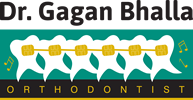Being informed about orthodontic procedures and braces for your children is important. Dr. Bhalla has offered a glossary of terms about orthodontic procedures in his Mississauga practice.
Adjustment: An evaluation of your progress, when your archwire or headgear may be changed or modified to keep your treatment on track and moving forward.
Banding: The process of cementing orthodontic bands to your teeth for braces or headgear.
Bonding: The process of attaching brackets to your teeth using a special, safe adhesive.
Cephalometric X-ray: This is useful for diagnosing orthodontic problems and planning orthodontic treatment. A Cephalometric X-ray, or ceph x-ray, differs from a regular dental x-ray or panoramic x-ray because it includes the entire side of the head. This gives the orthodontist a “big picture” view of what is happening with the teeth, jaw and face.
Consultation: A meeting with your orthodontist where he/she discusses an orthodontic treatment plan and if you need adult braces or if your need braces for your child.
Debanding: The removal of cemented orthodontic brackets and bands, a part of removing your braces.
Impressions: The first step in making a model of your teeth. An impression tray filled with dough like material will be squished around your teeth. That material hardens to produce a mold of your teeth. The molds are used to make study models of your teeth.
Panoramic X-ray: An x-ray taken by a machine that rotates around your head to give your orthodontist a picture of your teeth, jaws and other important information.
Records: These records, which include cephalometric and panoramic x-rays, digital photos and study models, help your orthodontist determine what treatment needs to be done.
Wax Bite: A procedure to measure how well your teeth come together. You bite a sheet of wax or special polymer and leave bite marks in the material. This helps the orthodontist see how the upper and lower teeth come together, especially when working with the study models.
